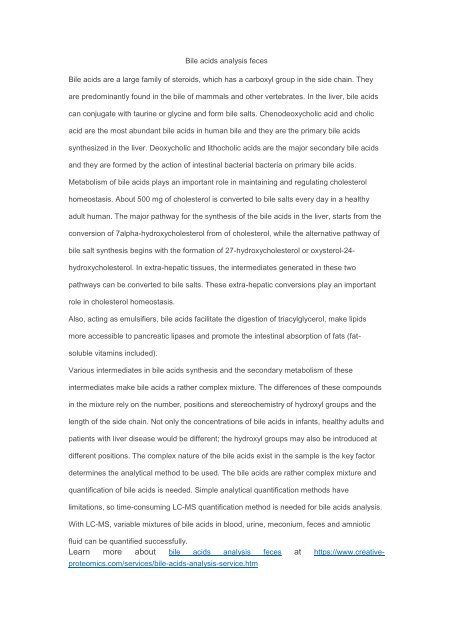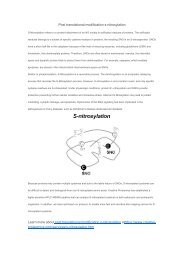bile acids analysis feces
Bile acids are a large family of steroids, which has a carboxyl group in the side chain. They are predominantly found in the bile of mammals and other vertebrates. In the liver, bile acids can conjugate with taurine or glycine and form bile salts. Chenodeoxycholic acid and cholic acid are the most abundant bile acids in human bile and they are the primary bile acids synthesized in the liver. Deoxycholic and lithocholic acids are the major secondary bile acids and they are formed by the action of intestinal bacterial bacteria on primary bile acids. https://www.creative-proteomics.com/services/bile-acids-analysis-service.htm
Bile acids are a large family of steroids, which has a carboxyl group in the side chain. They are predominantly found in the bile of mammals and other vertebrates. In the liver, bile acids can conjugate with taurine or glycine and form bile salts. Chenodeoxycholic acid and cholic acid are the most abundant bile acids in human bile and they are the primary bile acids synthesized in the liver. Deoxycholic and lithocholic acids are the major secondary bile acids and they are formed by the action of intestinal bacterial bacteria on primary bile acids. https://www.creative-proteomics.com/services/bile-acids-analysis-service.htm
You also want an ePaper? Increase the reach of your titles
YUMPU automatically turns print PDFs into web optimized ePapers that Google loves.
Bile <strong>acids</strong> <strong>analysis</strong> <strong>feces</strong><br />
Bile <strong>acids</strong> are a large family of steroids, which has a carboxyl group in the side chain. They<br />
are predominantly found in the <strong>bile</strong> of mammals and other vertebrates. In the liver, <strong>bile</strong> <strong>acids</strong><br />
can conjugate with taurine or glycine and form <strong>bile</strong> salts. Chenodeoxycholic acid and cholic<br />
acid are the most abundant <strong>bile</strong> <strong>acids</strong> in human <strong>bile</strong> and they are the primary <strong>bile</strong> <strong>acids</strong><br />
synthesized in the liver. Deoxycholic and lithocholic <strong>acids</strong> are the major secondary <strong>bile</strong> <strong>acids</strong><br />
and they are formed by the action of intestinal bacterial bacteria on primary <strong>bile</strong> <strong>acids</strong>.<br />
Metabolism of <strong>bile</strong> <strong>acids</strong> plays an important role in maintaining and regulating cholesterol<br />
homeostasis. About 500 mg of cholesterol is converted to <strong>bile</strong> salts every day in a healthy<br />
adult human. The major pathway for the synthesis of the <strong>bile</strong> <strong>acids</strong> in the liver, starts from the<br />
conversion of 7alpha-hydroxycholesterol from of cholesterol, while the alternative pathway of<br />
<strong>bile</strong> salt synthesis begins with the formation of 27-hydroxycholesterol or oxysterol-24-<br />
hydroxycholesterol. In extra-hepatic tissues, the intermediates generated in these two<br />
pathways can be converted to <strong>bile</strong> salts. These extra-hepatic conversions play an important<br />
role in cholesterol homeostasis.<br />
Also, acting as emulsifiers, <strong>bile</strong> <strong>acids</strong> facilitate the digestion of triacylglycerol, make lipids<br />
more accessible to pancreatic lipases and promote the intestinal absorption of fats (fatsoluble<br />
vitamins included).<br />
Various intermediates in <strong>bile</strong> <strong>acids</strong> synthesis and the secondary metabolism of these<br />
intermediates make <strong>bile</strong> <strong>acids</strong> a rather complex mixture. The differences of these compounds<br />
in the mixture rely on the number, positions and stereochemistry of hydroxyl groups and the<br />
length of the side chain. Not only the concentrations of <strong>bile</strong> <strong>acids</strong> in infants, healthy adults and<br />
patients with liver disease would be different; the hydroxyl groups may also be introduced at<br />
different positions. The complex nature of the <strong>bile</strong> <strong>acids</strong> exist in the sample is the key factor<br />
determines the analytical method to be used. The <strong>bile</strong> <strong>acids</strong> are rather complex mixture and<br />
quantification of <strong>bile</strong> <strong>acids</strong> is needed. Simple analytical quantification methods have<br />
limitations, so time-consuming LC-MS quantification method is needed for <strong>bile</strong> <strong>acids</strong> <strong>analysis</strong>.<br />
With LC-MS, variable mixtures of <strong>bile</strong> <strong>acids</strong> in blood, urine, meconium, <strong>feces</strong> and amniotic<br />
fluid can be quantified successfully.<br />
Learn more about <strong>bile</strong> <strong>acids</strong> <strong>analysis</strong> <strong>feces</strong> at https://www.creativeproteomics.com/services/<strong>bile</strong>-<strong>acids</strong>-<strong>analysis</strong>-service.htm





